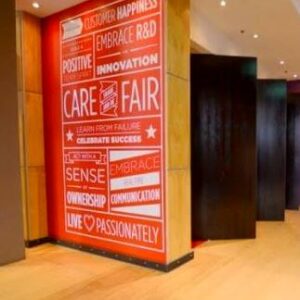“First we shape our buildings; thereafter, they shape us.”
—Sir Winston Churchill
What a wise observation. I love the idea that we have a hand in creating a world that eventually influences us.
When I first heard this quote during last week’s “World of Workspaces” #TChat Radio show, I was fascinated. Workplace design expert, Chris Congdon of Steelcase, shared the concept as she talked about developing work environments that support organizational goals.
Among other things, Chris explained how physical workspace influences the way we feel and act. For example, if a company wants to foster collaboration, creativity and innovation, merely filling an office with tall cubicles and fluorescent lighting just isn’t going to cut it.
Great Workplaces: Beyond Tangibles
Her primary message was this: The best places to work are designed from the inside-out. It’s not enough to consider only the tasks that must be accomplished in a space. Nor is it enough to focus on ergonomics that make those workflows more comfortable or efficient. Before we can build business spaces that optimize performance and engagement, we must understand human motivation and behavior in workplace settings.
Actually, on a larger scale, isn’t that how leaders approach corporate culture? Our mission is to create not just physical space, but complete ecosystems that bring out the best in every contributor. And in turn, that ecosystem rewards us in ways that reflect and reinforce our brand vision and values. It’s a continuous loop.
“First we shape our culture; thereafter, our culture shapes us…”
So, just as color schemes, work surfaces and lighting must be carefully considered when developing any physical workspace, we must be equally deliberate in developing organizational culture, piece by piece.
Snapshot Assessment
That conclusion triggered a reality check for me. I quickly took a mental inventory of the physical environment and the organizational “vibe” at Achievers. Here are several highlights, and the intentions behind them:
 1) Open Design: Our workspaces are based on open floor plans and are surrounded by lots of natural light. There are very few individual offices. That’s intentional. We want our environment to encourage the kind of energy and enthusiasm that we hope is synonymous with our product.
1) Open Design: Our workspaces are based on open floor plans and are surrounded by lots of natural light. There are very few individual offices. That’s intentional. We want our environment to encourage the kind of energy and enthusiasm that we hope is synonymous with our product.
2) Visual Cues: Our Toronto office features a giant red wall inscribed with our company values. It’s one of the first things you see as you enter the front door of the building. Such a public display of company values may not guarantee that all employees internalize them, but it’s a constant reminder to employees, customers and business partners of what we want to represent.
3) Flexibility: Steelcase reminds us that individuals prefer to structure their own tasks throughout their day. That’s why we offer a variety of options — group seating for collaboration, as well as various quiet and private areas. The more options we offer, the more likely our employees will feel they “fit” into the environment — regardless of their mood or work requirements. Actually, this philosophy aligns with employee recognition best practices as well (our area of expertise at Achievers). It’s human nature. Under some circumstances, a person responds best to public recognition. Other times a private, sincere expression of gratitude is more effective. Variety is the solution.
4) Reinforcement: We believe that the most critical step any company can take in creating a workplace is to build a culture of “thank you.” Of course, employee recognition isn’t as visible as desks or chairs, but it is likely to be the most durable investment you’ll ever make. If you reinforce behaviors that move business goals forward and encourage employees to embrace core values, these intangibles will become as integral to your organization as the furniture.
Bottom line: When designing a workplace — don’t forget to decorate early and often with recognition!
Image Credit: Pixabay
Post Views: 2,227